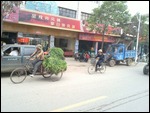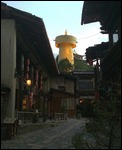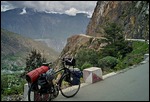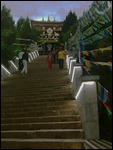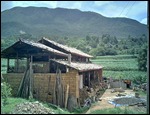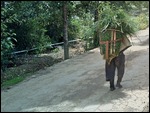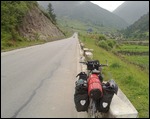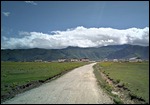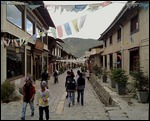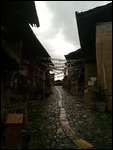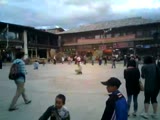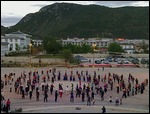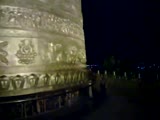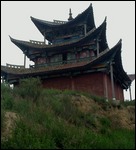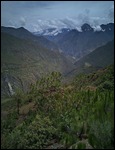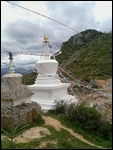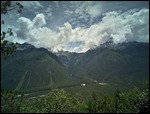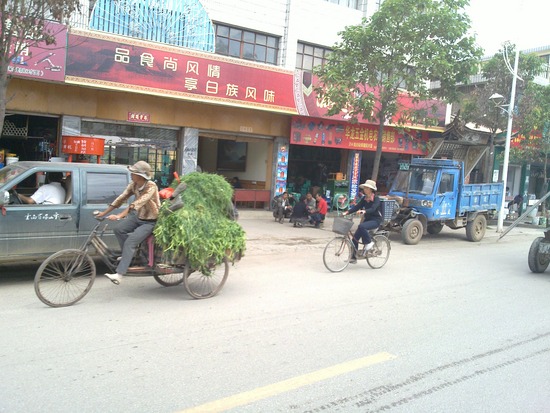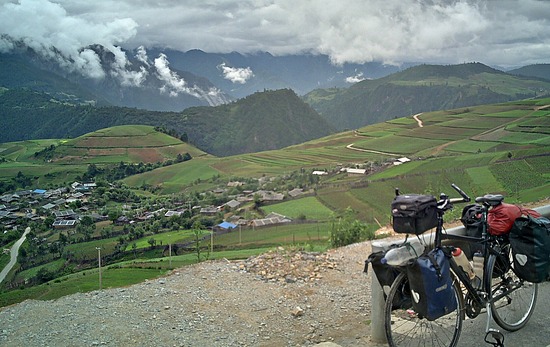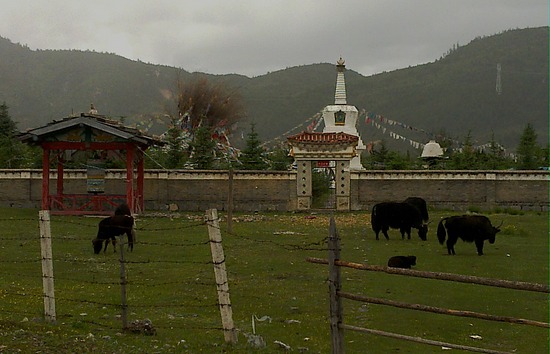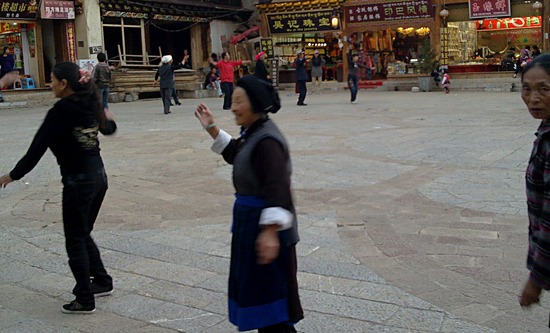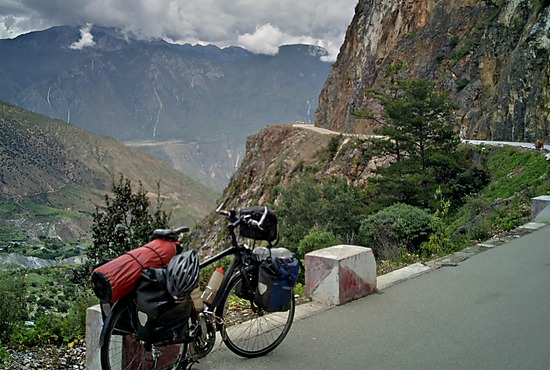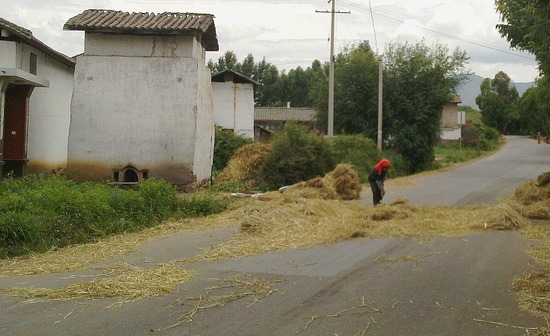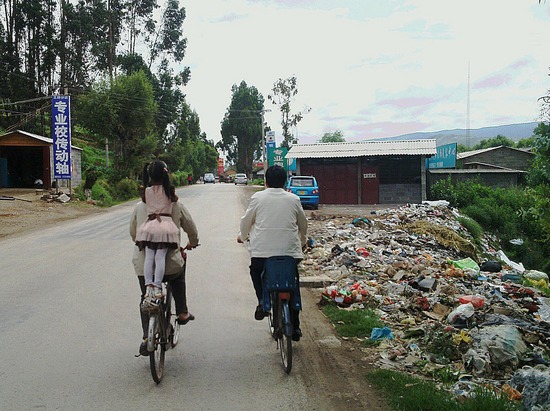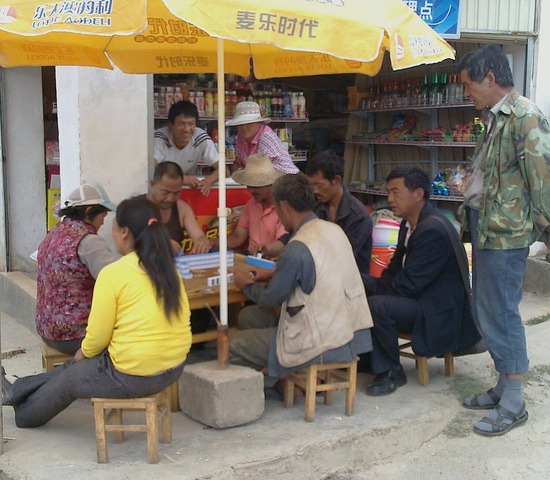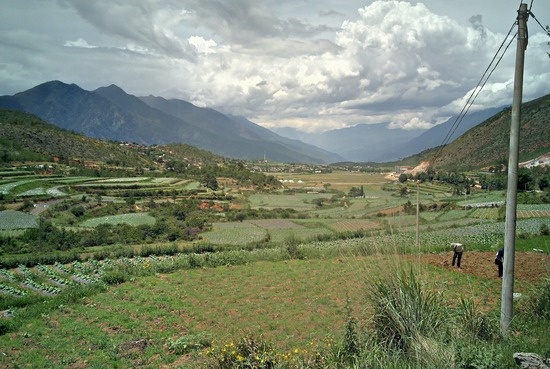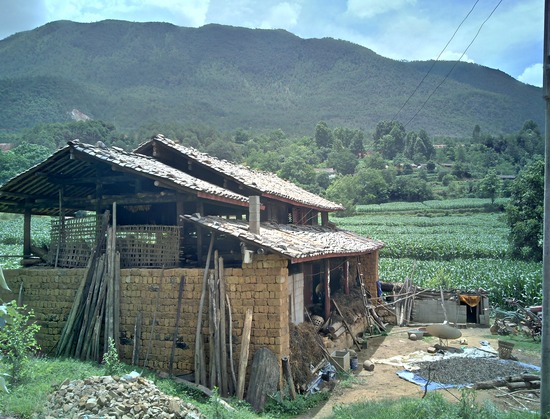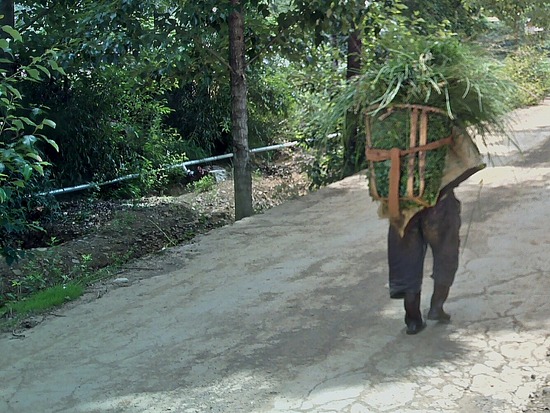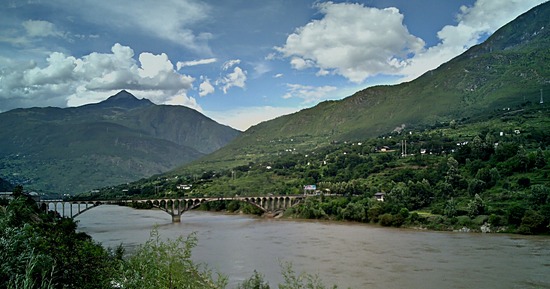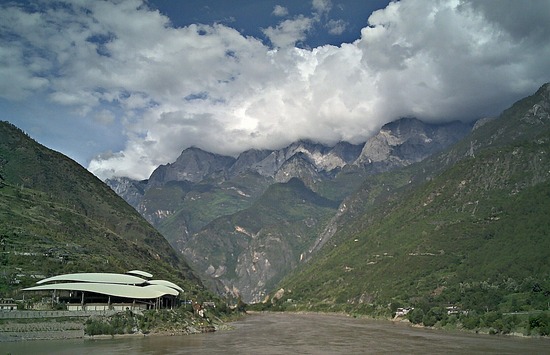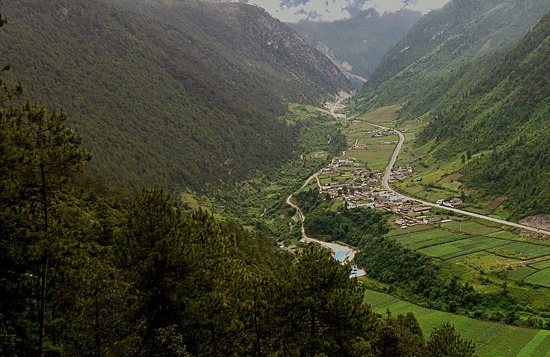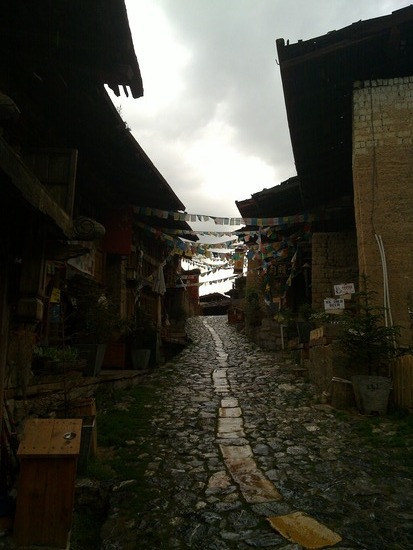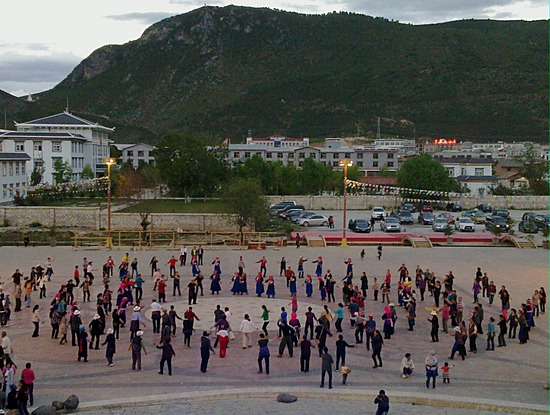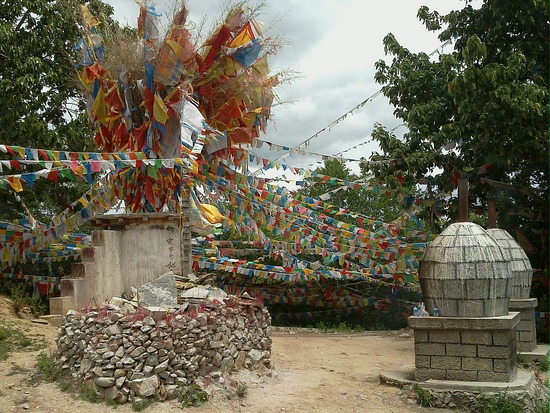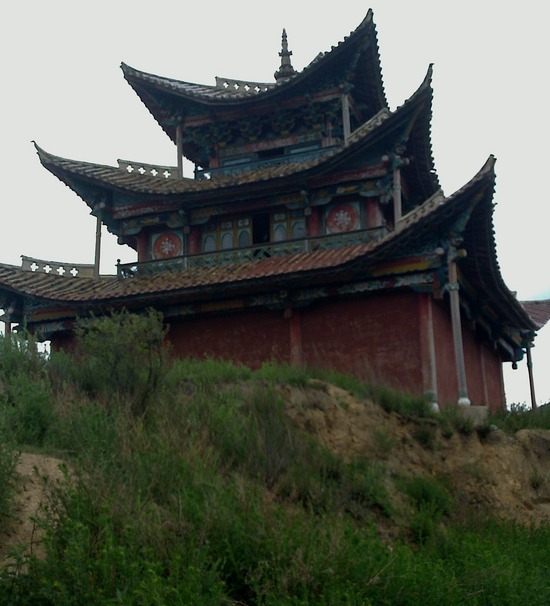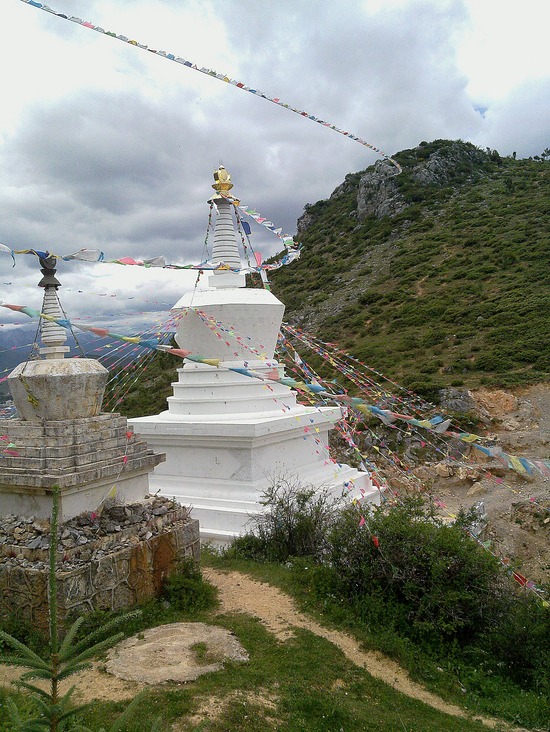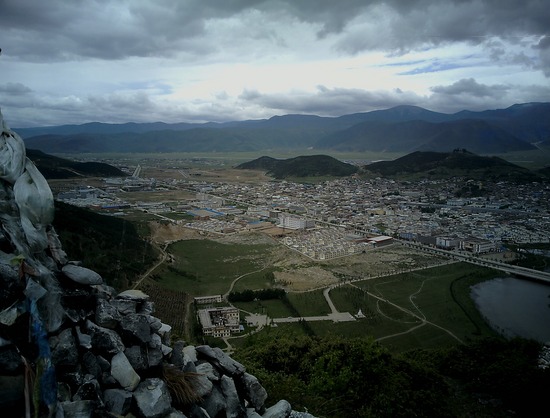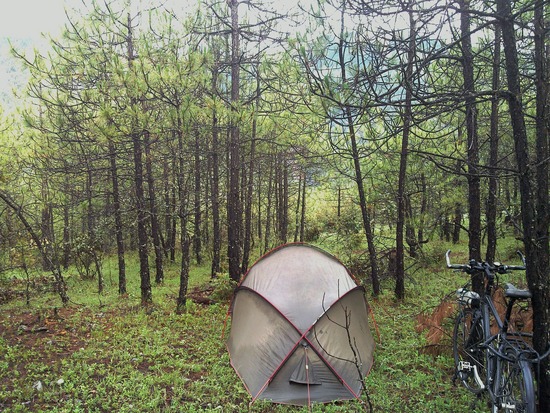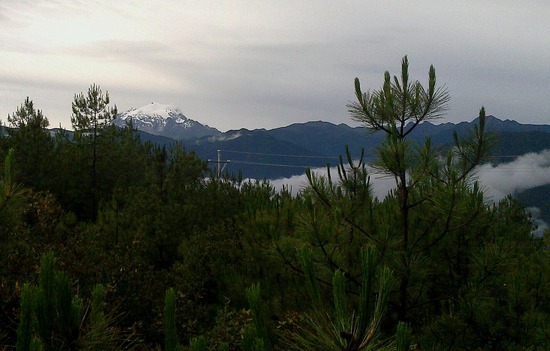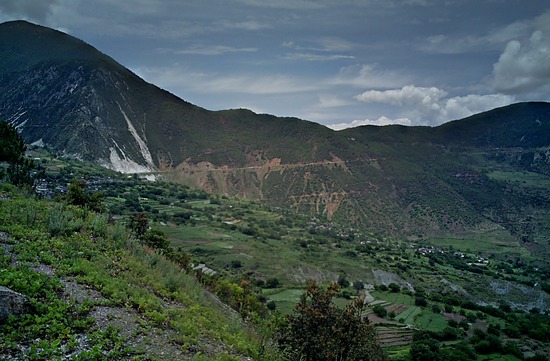A brief scan of my map had shown me that there were two northward highways, but a lack of attention to scale meant I missed the fact one of them bypassed my intended destination of Li Jiang by a margin of some 50 kms. And it was this highway I crossed to. The road soon came to an end, but preferring not to turn back I navigated the section still under construction where male and female road workers with hand tools smiled and waved.
After the construction zone, the highway resumed as a single lane each direction, and although drivers were courteous overall, the honking and the unending stream of heavy trucks that grew as I progressed made the riding unpleasant. After a good deal of searching, I found a place to camp high on a hillside by a large, unfinished house attended by a rooster and a stray dog. The sounds of ongoing construction work on the new expressway nearby continued into the night.
In morning, I passed the turning to an unexpectedly distant Li Jiang, and so decided to continue on to Shangri-La first. The road descended quite suddenly into the Jin Sha river valley, where a sliver of flat land accompanied the river between two unbroken chains of mountains. The gargantuan concrete flyovers of the nascent expressway seemed discordant with the farm houses and rice paddies they overstepped - the people of the valley seemed nonchalant. The road under construction merged with the highway in places, and intermittent rain showers turned all to a mess of mud and potholes. Trucks became particularly unwelcome in these spots.
As I rested by the roadside, a woman returning from the fields bearing a load of grass in an enormous basket strapped to her back observed me with curiosity; we exchanged a few words in Chinese, of which I comprehended little. Then she remarked “Wǒ sh� Zhōng gu� r�n” (I am Chinese) as she continued on her way, leaving me a little nonplussed.
Clouds obscured the massive Jade Snow mountain, but I caught glimpses of the magnificent vertical rock walls of Tiger Leaping Gorge as I passed opposite its entrance the other side of the Jin Sha. Brice (whom I'd met in Luang Prabang) had suggested that an expensive entry fee to the gorge could be avoided doing the gorge east to west, so I decided to continue north to Shangri-La and return via the long route back through the gorge.
Daylight was fading in the valley as I left the small settlement of Hu Tiao Xia toting a cooked meal. River valleys often don’t provide for much in the way of stealth camping, and this one, that of a narrow tributary of the Jin Sha, was typical in that regard. I regarded keenly each prospective camping place I passed, evaluating and ranking them as I wondered if any would be secluded enough to assure me of a safe night’s rest. Finally, I found a small, overgrown track leading into some bush beside the road, and to a perfect haven for the night.
The climbing was steady but not particularly steep the next day; for most of my time in China’s mountainous Yun Nan province, I've been cycling in the range of 2,000 to 2,500 m altitude, so this climb onto the Qinghai-Tibetan plateau and Shangri-La's 3,200 m was not as difficult as it might sound. The road lifted out of the river valley, and things gradually leveled out. To find such expansive plains at such an altitude took me unexpected - it was as if the rest of the world existed below in a vast depression.
Although only touching the very edge of it, I marvelled at this world above the world, formed when the Indian subcontinent subducted beneath the Asian plate, creating an area four times the size of France with an average elevation of 5,000 m.
Fighting the wind, I began to pass herds of horses and yaks, as well as the massive Tibetan houses (some resembling small fortresses) and the great wooden frames they use to dry yak hides. The plains were barren in the bone-dry air, with mostly light grass and some alpine shrubs and flowers, in contrast to the fertility I’d left at lower altitudes.
Busloads of Chinese tourists passed me, many stopping for photographs with a group of young ethnic Tibetans who posed with a herd of yaks in a roadside pasture. Finally, an enormous stupa situated at a road junction indicated I was near my goal, but even the bilingual road signs left me none the wiser as to which road to take - after some deliberation I realised I needed only follow the buses to find my way in.
The old city was pretty touristic, and swarmed with visitors. After a lot of searching, I found the Harmony guest house, where the down to earth nature of the two young Tibetan women who ran the place, along with the cat and large dog made for a homely ambience. The woodstove burned all day, but I, perhaps uniquely, welcomed the marked drop in temperature that accompanied the increase in altitude.
Each evening, twenty to thirty locals congregated in a small square of the old city and danced in a large circle. There was a disarming sincerity in their movements and expressions of enjoyment that made it hard not to smile with them.
A much larger version of the dance took place in the main square, perhaps half a kilometre away, in which a hundred or more participated each evening. Several impressive flights of stairs and traditional Chinese gateways rose to a small hilltop temple and a 15 m high Tibetan prayer wheel I’d observed in perpetual rotation from the roof of the guesthouse. On reaching the wheel, I was surprised to find that it was not motorised, but kept in motion by a stream of mostly Han tourists, each performing the prescribed three clockwise rotations held to propagate the Dharma.
A young Chinese man greeted me on the temple stairs and we began conversing in English. There was mutual surprise when it emerged we were both cyclists; he and a friend had cycled all the way from Gui Lin, almost 2,000 km to the east. Both were Linux software developers, employed by a manufacturer of set-top boxes, although one had quit his job before setting off with no firm idea of when he might re-enter the workforce. They continued on towards Tibet the next morning. The autonomous region was at this time closed to non-Chinese, and I was slightly envious of the fact they’d be fairly free to roam at will, unlike visitors to China (as my friend Charlie found in his brief exploration sans permit - I highly recommend you click this link and read his account of his time cycling alone in Tibet illegally, in mid-winter!).
A friendly Polish woman I’d met on arriving appeared at the guesthouse a few days later, along with a couple of Czechs who were on their way home from nine months in NZ. We did some hiking in the hills around the city together, visiting several shrines and stupas where incense burned and Tibetan prayer flags flapped in the chilling wind.
I left Shangri-La in light rain showers, which grew heavier as the valley rose in altitude. After a couple of hours, the highest point loomed, and a friendly farmer invited me to grab hold of his trailer and towed me the last kilometre or so to the top. Then I had but to relax and enjoy a long descent, but my enthusiasm got the better of me and as I tried to take a racing driver’s line through a hair-pin corner, leaning in at speed, the wheels slipped from below me; a time-stretched instant of weightlessness, then falling, just long enough to be overcome with distress at the imminent meeting of skin with asphalt.
A short slide on the road surface checked my inertia and then I picked myself up before the pain had fully registered. To my relief, nothing seemed broken, but I had several deep grazes on the knee and elbow, and my hand and several toes were also bloodied. I didn’t stop to clean or dress my wounds, and a few hours later a roadside pine forest behind a small village provided an ideal spot to do so and make camp, though things were made more difficult by a pain in my ribs that had grown progressively in intensity since the fall.
Night fell and I skipped dinner, sleeping easily. The rain returned and continued through the night.
A distant Jade Snow mountain was again visible in the clear morning sky, and only my rib troubled me as I packed and set off. There were very few cars on the road and I was only slightly more cautious than the usual in regulating my bicycle’s downward urging. The spectacular scenery left me with a sense of levity that my injuries could not assail. The road twisted ever deeper, seemingly into the heart of the earth, via yawning canyons, where villages dominated improbable staircases of rice.
And not for the first time, I envied and romanticised the life of the people through whose lands I voyaged - the wholesome, simple life of the Chinese rural population; their grit and steadfast, no-nonsense work ethic. I admired them deeply, as much as I had the people of rural India, for their toughness and their ability to knuckle down and still smile in conditions most people I know would find unbearable, and I contemplated the gulf between their world and the luxurious world in which I grew up. Well, I warned you it was romanticised!
The terrain became rockier as I neared Tiger Leaping Gorge, the road wrapping around the rock faces, all of this grandeur taking me out of myself and then bringing me back to the present moment; causing me to reflect on how fortunate I was to be exploring this piece of the world, as free as a bird.
After a pass gave way to one last, long descent, I neared the entry to Tiger Leaping Gorge, meeting some sunburnt Israelis and an American who had just hiked its length. We shared our experiences and I exchanged some US dollars for Yuan with them. A van pulled up and offered them a lift back to civilisation, and I continued into the valley...
